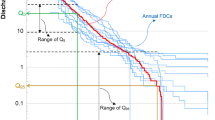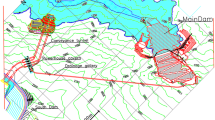Abstract
Shallow reservoirs are hydraulic structures widely used for water storage or as sedimentation tanks. Their design and sizing are intricate due to the complex flow fields developing in such structures, hence suitable indicators are needed to evaluate their hydraulic performance. Based on the outcomes of a depth-averaged computational model, we analysed the potential of the distribution function of the volume-averaged water age to unveil in a concise way valuable information on the flow field in rectangular shallow reservoirs. Ten different reservoir layouts were examined. In all cases, the shape of the computed distribution function reveals a remarkable amount of information on the flow field in the reservoirs. The distribution functions exhibit a sequence of steps, followed by an exponential decay, which may be related to fast and slow pathways travelled by water particles along their routes across the reservoirs. As such, the distribution function of the volume-averaged water age was found to provide valuable information for assessing the hydraulic performance of shallow reservoirs, while achieving an effective reduction in the problem dimensionality.







Similar content being viewed by others
References
Dufresne M, Vazquez J, Terfous A, Ghenaim A, Poulet J-B (2009) Experimental investigation and CFD modelling of flow, sedimentation, and solids separation in a combined sewer detention tank. Comput Fluids 38:1042–1049
Isenmann G, Dufresne M, Vazquez J, Mose R (2017) Bed turbulent kinetic energy boundary conditions for trapping efficiency and spatial distribution of sediments in basins. Water Sci Technol 76:2032–2043
Sebastian C, Becouze-Lareure C, Lipeme Kouyi G, Barraud S (2014) Event-based quantification of emerging pollutant removal for an open stormwater retention basin - loads, efficiency and importance of uncertainties. Water Res 72:239–250
Tsavdaris A, Mitchell S, Williams JB (2015) Computational fluid dynamics modelling of different detention pond configurations in the interest of sustainable flow regimes and gravity sedimentation potential. Water Environ J 29:129–139
Adamsson Å, Stovin V, Bergdahl L (2003) Bed shear stress boundary condition for storage tank sedimentation. J Environ Eng 129:651–658
Guzman CB, Cohen S, Xavier M, Swingle T, Qiu W, Nepf H (2018) Island topographies to reduce short-circuiting in stormwater detention ponds and treatment wetlands. Ecol Eng 117:182–193
Persson J, Wittgren HB (2003) How hydrological and hydraulic conditions affect performance of ponds. Ecol Eng 21:259–269
Persson J (2000) The hydraulic performance of ponds of various layouts. Urban Water 2:243–250
Persson J, Somes NLG, Wong THF (1999) Hydraulics efficiency of constructed wetlands and ponds. Water Sci Technol 40:291–300
Liu X, Xue H, Hua Z, Yao Q, Hu J (2013) Inverse calculation model for optimal design of rectangular sedimentation tanks. J Environ Eng (US) 139:455–459
Lakzian E, Saghi H, Kooshki O (2020) Numerical simulation of sediment deposition and trapping efficiency estimation in settling basins, considering secondary flows. Int J Sedim Res 35:347–354
Izdori F, Semiao AJC, Perona P (2019) The role of environmental variables in waste stabilization ponds’ morphodynamics. Front Environ Scince 7:159
Goula AM, Kostoglou M, Karapantsios TD, Zouboulis AI (2008) A CFD methodology for the design of sedimentation tanks in potable water treatment. Case study: the influence of a feed flow control baffle. Chem Eng J 140:110–121
Zhang J-M, Lee HP, Khoo BC, Peng KQ, Zhong L, Kang C-W, Ba T (2014) Shape effect on mixing and age distributions in service reservoirs. J Am Water Works Assoc 106:E481–E491
Claude N, Secher M, Deng J, Valette E, Duclercq M (2020) Numerical modeling of flow and sediment transport in a real shallow reservoir: Comparison between 2D and 3D simulation. In: River Flow 2020-Proceedings of the 10th Conference on Fluvial Hydraulics, (pp. 331–339)
Dufresne M, Vazquez J, Terfous A, Ghenaim A, Poulet J-B (2009) CFD modeling of solid separation in three combined sewer overflow chambers. J Environ Eng 135:776–787
Tarpagkou R, Pantokratoras A (2013) CFD methodology for sedimentation tanks: the effect of secondary phase on fluid phase using DPM coupled calculations. Appl Math Model 37:3478–3494
Li H, Sansalone J (2021) CFD with evolutionary optimization for stormwater basin retrofits. J Environ Eng (US) 147:04021017
Rowland JC, Stacey MT, Dietrich WE (2009) Turbulent characteristics of a shallow wall-bounded plane jet: Experimental implications for river mouth hydrodynamics. J Fluid Mech 627:423–449
Canestrelli A, Nardin W, Edmonds D, Fagherazzi S, Slingerland R (2014) Importance of frictional effects and jet instability on the morphodynamics of river mouth bars and levees. J Geophys Res Oceans 119:509–522
Milovanovic I, Bareš V, Hedström A, Herrmann I, Picek T, Marsalek J, Viklander M (2020) Enhancing stormwater sediment settling at detention pond inlets by a bottom grid structure (BGS). Water Sci Technol 81:274–282
Grayman WM, Rossman LA, Deininger RA, Smith CD, Arnold CN, Smith JF (2004) Mixing and aging of water in distribution system storage facilities. J Am Water Works Assoc 96:70–80
Stovin VR, Saul AJ (2000) Computational fluid dynamics and the design of sewage storage chambers. Water Environ J 14:103–110
Dufresne M, Dewals BJ, Erpicum S, Archambeau P, Pirotton M (2010) Classification of flow patterns in rectangular shallow reservoirs. J Hydraul Res 48:197–204
Peltier Y, Erpicum S, Archambeau P, Pirotton M, Dewals B (2014) Experimental investigation of meandering jets in shallow reservoirs. Environ Fluid Mech 14:699–710
Dewals BJ, Kantoush SA, Erpicum S, Pirotton M, Schleiss AJ (2008) Experimental and numerical analysis of flow instabilities in rectangular shallow basins. Environ Fluid Mech 8:31–54
Choufi L, Kettab A, Schleiss AJ (2014) Bed roughness effect on flow field in rectangular shallow reservoir [Effet de la rugosité du fond d’un réservoir rectangulaire à faible profondeur sur le champ d’écoulement], Houille Blanche 83–92.
Camnasio E, Orsi E, Schleiss AJ (2011) Experimental study of velocity fields in rectangular shallow reservoirs. J Hydraul Res 49:352–358
Goltsman, A., and Saushin, I. (2019) Flow pattern of double-cavity flow at high Reynolds number, Physics of Fluids 31.
Miozzi M, Romano GP (2020) Propagation of perturbations and meandering in a free surface shallow water jet. Experiments Fluids 61:065101
Camnasio E, Erpicum S, Orsi E, Pirotton M, Schleiss AJ, Dewals B (2013) Coupling between flow and sediment deposition in rectangular shallow reservoirs. J Hydraul Res 51:535–547
Dufresne M, Dewals BJ, Erpicum S, Archambeau P, Pirotton M (2010) Experimental investigation of flow pattern and sediment deposition in rectangular shallow reservoirs. Int J Sedim Res 25:258–270
Yan H, Vosswinkel N, Ebbert S, Lipeme Kouyi G, Mohn R, Uhl M, Bertrand-Krajewski J-L (2020) Numerical investigation of particles’ transport, deposition and resuspension under unsteady conditions in constructed stormwater ponds. Environ Sci Europe 32:1–17
Dominic JA, Aris AZ, Sulaiman WNA, Tahir WZWM (2016) Discriminant analysis for the prediction of sand mass distribution in an urban stormwater holding pond using simulated depth average flow velocity data. Environ Monit Assess 188:1–15
Kantoush SA, De Cesare G, Boillat JL, Schleiss AJ (2008) Flow field investigation in a rectangular shallow reservoir using UVP LSPIV and numerical modelling. Flow Meas Instrum 19:139–144
Peltier Y, Erpicum S, Archambeau P, Pirotton M, Dewals B (2015) Can meandering flows in shallow rectangular reservoirs be modeled with the 2D shallow water equations? J Hydraul Eng 141:04015008
Dufresne M, Dewals BJ, Erpicum S, Archambeau P, Pirotton M (2011) Numerical investigation of flow patterns in rectangular shallow reservoirs. Eng Appl Comput Fluid Mech 5:247–258
Ferrara V, Erpicum S, Archambeau P, Pirotton M, Dewals B (2018) Flow field in shallow reservoir with varying inlet and outlet position. J Hydraul Res 56:689–696
Kantoush SA, Bollaert E, Schleiss AJ (2008) Experimental and numerical modelling of sedimentation in a rectangular shallow basin. Int J Sedim Res 23:212–232
Esmaeili T, Sumi T, Kantoush SA, Haun S, Rüther N (2016) Three-dimensional numerical modelling of flow field in shallow reservoirs. Proc Inst Civ Eng Water Manag 169:229–244
Zahabi H, Torabi M, Alamatian E, Bahiraei M, Goodarzi M (2018) Effects of geometry and hydraulic characteristics of shallow reservoirs on sediment entrapment. Water (Switzerland) 10:1725
Lucas LV, Deleersnijder E (2021) Tracers and timescales: Tools for distilling and simplifying complex fluid mechanical problems. Water (Switzerland) 13:2796
Deleersnijder E, Delhez EJM (2007) Timescale- and tracer-based methods for understanding the results of complex marine models. Estuar Coast Shelf Sci 74:v–vii
Deleersnijder E, Campin J-M, Delhez EJM (2001) The concept of age in marine modelling I. Theory and preliminary model results. J Mar Syst 28:229–267
Bolin B, Rodhe H (1973) A note on the concepts of age distribution and transit time in natural reservoirs. Tellus 25:58–62
Monsen NE, Cloern JE, Lucas LV, Monismith SG (2002) A comment on the use of flushing time, residence time, and age as transport time scales. Limnol Oceanogr 47:1545–1553
Takeoka H (1984) Fundamental concepts of exchange and transport time scales in a coastal sea. Cont Shelf Res 3:311–326
Xavier MLM, Janzen JG (2017) Effects of inlet momentum and orientation on the hydraulic performance of water storage tanks. Appl Water Sci 7:2545–2557
Moncho-Esteve IJ, Palau-Salvador G, Brevis W, Vaas MO, López-Jiménez PA (2015) Numerical simulation of the hydrodynamics and turbulent mixing process in adrinking water storage tank. J Hydraul Res 53:207–217
Sonnenwald F, Guymer I, Stovin V (2018) Computational fluid dynamics modelling of residence times in vegetated stormwater ponds. Proc Inst Civ Eng Water Manag 171:76–86
Dewals B, Archambeau P, Bruwier M, Erpicum S, Pirotton M, Adam T, Delhez E, Deleersnijder E (2020) Age of water particles as a diagnosis of steady-state flows in shallow rectangular reservoirs. Water (Switzerland) 12:2819
Camnasio E, Erpicum S, Archambeau P, Pirotton M, Dewals B (2014) Prediction of mean and turbulent kinetic energy in rectangular shallow reservoirs. Eng Appl Comput Fluid Mech 8:586–597
Erpicum S, Meile T, Dewals BJ, Pirotton M, Schleiss AJ (2009) 2D numerical flow modeling in a macro-rough channel. Int J Numer Meth Fluids 61:1227–1246
Stamou AI (2002) Verification and application of a mathematical model for the assessment of the effect of guiding walls on the hydraulic efficiency of chlorination tanks. J Hydroinf 4:245–254
Mouchet A, Deleersnijder E, Primeau F (2012) The leaky funnel model revisited. Tellus Ser A Dyn Meteorol Oceanograph 64:19131
Ahmed SS, Loewen MR, Zhang W, Ghobrial TR, Zhu DZ, Mahmood K, van Duin B (2022) Field observations of stratification in stormwater wet ponds. J Environ Manag 322:115988
Song K, Xenopoulos MA, Buttle JM, Marsalek J, Wagner ND, Pick FR, Frost PC (2013) Thermal stratification patterns in urban ponds and their relationships with vertical nutrient gradients. J Environ Manag 127:317–323
Pilotti M, Simoncelli S, Valerio G (2014) A simple approach to the evaluation of the actual water renewal time of natural stratified lakes. Water Resour Res 50:2830–2849
Funding
No funding was received for conducting this study.
Author information
Authors and Affiliations
Contributions
ED, BD and PA conceptualized the research and designed the methodology. BD and PA developed the computer codes for data analysis and performed formal analysis. BD wrote the original draft, which was revised by SE and ED MP provided expertise.
Corresponding author
Ethics declarations
Conflict of interest
The authors declare no competing interests.
Additional information
Publisher's Note
Springer Nature remains neutral with regard to jurisdictional claims in published maps and institutional affiliations.
Supplementary Information
Below is the link to the electronic supplementary material.
Rights and permissions
Springer Nature or its licensor (e.g. a society or other partner) holds exclusive rights to this article under a publishing agreement with the author(s) or other rightsholder(s); author self-archiving of the accepted manuscript version of this article is solely governed by the terms of such publishing agreement and applicable law.
About this article
Cite this article
Dewals, B., Archambeau, P., Erpicum, S. et al. What does the volume-averaged water age distribution function reveal about flow fields in rectangular shallow reservoirs?. Environ Fluid Mech 24, 75–93 (2024). https://doi.org/10.1007/s10652-024-09967-z
Received:
Accepted:
Published:
Issue Date:
DOI: https://doi.org/10.1007/s10652-024-09967-z




